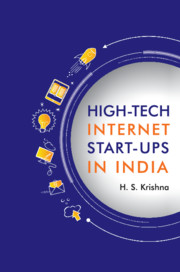Book contents
- Frontmatter
- Dedication
- Contents
- List of Tables
- List of Figures
- Preface
- Acknowledgements
- 1 Introduction
- 2 Objectives, Scope, and Methodology
- 3 High-tech Start-ups in India: Profile and Characteristics
- 4 Emergence of High-tech Start-ups
- 5 Survival of High-tech Start-ups
- 6 Growth of High-tech Start-ups
- 7 Factors influencing Life Cycle of High-tech Start-ups
- 8 Conclusions
- Bibliography
- Index
8 - Conclusions
Published online by Cambridge University Press: 12 June 2019
- Frontmatter
- Dedication
- Contents
- List of Tables
- List of Figures
- Preface
- Acknowledgements
- 1 Introduction
- 2 Objectives, Scope, and Methodology
- 3 High-tech Start-ups in India: Profile and Characteristics
- 4 Emergence of High-tech Start-ups
- 5 Survival of High-tech Start-ups
- 6 Growth of High-tech Start-ups
- 7 Factors influencing Life Cycle of High-tech Start-ups
- 8 Conclusions
- Bibliography
- Index
Summary
Introduction
High-tech start-ups are now being recognized as the engines of economic growth in the knowledge-driven society. Their ability to generate new products, services, and business models has helped nations to leapfrog its output in comparison to others (Saxenian 2002). Developed economies in particular have benefited the most by supporting and nurturing high-tech start-ups. Several studies examining economic progress of developed economies have noted small high-tech start-ups as being the major drivers of job creation and innovation and thus, the economic growth (Birch 1979; Baumol 2002; Kirchhoff and Spencer 2008).
As an example of this, in the USA, these entrepreneurial companies contributed 20 per cent of the US employment in the 1980s. Even though in recession, from March 2009 and March 2010, 394,000 new businesses were formed in the USA, creating 2.3 million jobs (Mutikani 2012). Some of the leading companies in the technology industry today, such as Apple, Cisco, eBay, Qualcomm, Intel, were incubated as tiny start-ups during their formative years (Barringer, Jones, and Neubaum 2005; Paulraj 2012).
Over the last decade, the emerging economies across the world also have witnessed a surge in the creation of high-tech start-ups. The rapid proliferation and use of the Internet across the world has accelerated the process of globalization, aided by disruptive technological changes in just a matter of a decade and half (Startup Genome 2012). India has emerged as the third-largest base for high-tech start-ups in the world, with approximately 3100 start-ups operating in the country. The start-up ecosystem in India attracted 300 VC/ private equity and 225 angel investment deals worth over US$2.3 billion since 2010 and over 20 mergers and acquisitions worth US$1 billion in the last 3 years. Over the last 12 months alone, 805 technology product/digital start-ups were set up across the country, which is projected to grow fourfold to hit 2,000 by 2020 (NASSCOM 2014).
While the aforementioned data paint an impressive picture, it must be noted that across the world, these contributions are made from a very small percentage of high-tech start-ups which have successfully managed to overcome the challenges during initial stages of the firm life cycle. It has been well established that high-tech start-ups suffer a very heavy failure rate (Stinchcombe 1965; Certo 2003). These start-ups face many unique constraints during their initial stages of operation that makes them highly amenable to failure.
- Type
- Chapter
- Information
- High-tech Internet Start-ups in India , pp. 206 - 230Publisher: Cambridge University PressPrint publication year: 2019



